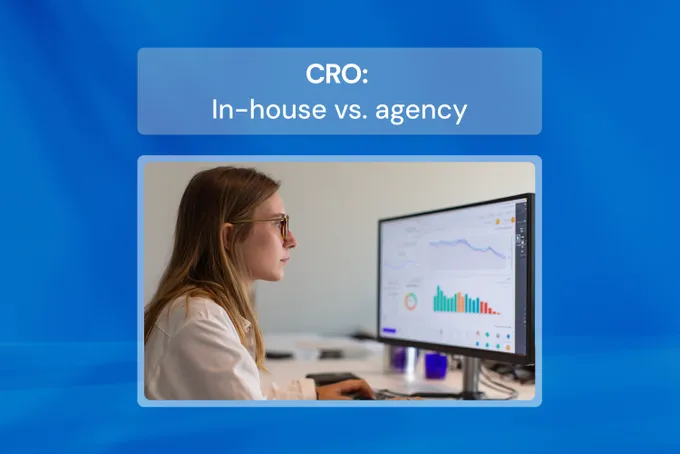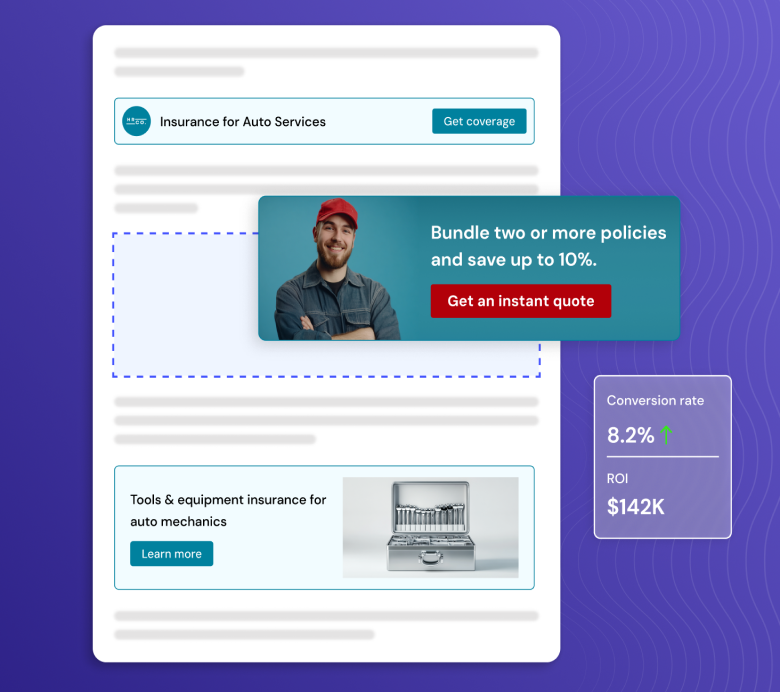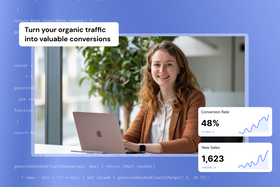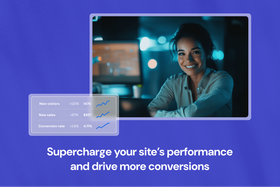CRO in-house vs. agency: What actually works and what doesn't
Struggling to choose between in-house CRO and agency partners? This guide reveals which model actually drives better conversion results for your business.
Updated December 2, 2025

You wouldn't be the first marketing leader to pick the wrong conversion rate optimization model and realize it six months too late.
Most companies frame it as a budget or headcount question, when the real variable is something else: where in your product do the experiments need to happen?
The problem compounds when you consider that most marketing teams don't have dedicated CRO specialists. They have growth marketers juggling acquisition, retention, and optimization simultaneously. Engineers who can spare a few hours per sprint for experimentation—maybe. Not everyone has the luxury of a fully staffed optimization team.
Before you commit to one model or the other, there's a framework that can help you make the right call, whether that's building in-house from the start, partnering with an agency long-term, or using an agency to build foundations before transitioning.
Key takeaways:
- Top-of-funnel suits agencies; product-embedded favors in-house.
- The best CRO programs start with an agency, then either transition to in-house ownership or evolve into a strategic partnership based on internal capacity.
- Own your tools and documentation from day one. You could lose 6–12 months of progress if agencies control the stack.
- Hybrid models rarely work unless ownership is cleanly separated and measurement is unified.
Before comparing costs or capabilities, answer these three questions
Budget spreadsheets and agency proposals will tell you one story. These three factors will tell you the truth about which model actually fits your situation.
How deep into your product do experiments need to go?
Landing pages, marketing sites, and sign-up flows suit agencies because these surfaces exist outside your core codebase. This means an external team can own execution without needing access to your engineering resources or institutional knowledge about why things work the way they do.
Deep product experimentation is different. Checkout flows, in-app features, product-led growth initiatives; these require context that agencies rarely have. Your design system. Your user journey. The specific levers that drive revenue versus the ones that just move vanity metrics. The more knowledge required to run meaningful experiments, the harder it becomes for an external team to perform.
An agency can A/B test your homepage headline. They'll struggle to optimize your upgrade flow if they don't understand why users resist the current one.
Do you have enough traffic for statistical confidence?
Pull up your analytics and calculate the minimum detectable effect for the surfaces you want to test. If your traffic volume can't support statistically significant results within a reasonable timeframe, hiring an agency to run quantitative A/B tests is burning money on experiments that won't tell you anything conclusive.
In-house teams have an advantage here that agencies can't replicate: direct access to user conversations. Support tickets, sales calls, customer interviews are qualitative research that can compensate for limited quantitative data. Your team can watch session recordings, talk to churned users, and develop hypotheses grounded in actual user behavior rather than waiting for sample sizes that may never materialize. Low-volume scenarios almost always favor in-house.
Can your team build a CRO program, or do they need guidance?
Most senior teams in 2025 have been exposed to CRO testing somewhere in their careers. Exposure isn't ownership capability. There's a difference between having run experiments at a previous company and knowing how to build prioritization frameworks, establish measurement protocols, and create iteration cycles from scratch.
If your project managers, engineers, and marketers have built experimentation programs before, they can likely stand one up internally with the right tooling. If they haven't (if they're working from blog posts and best-practice guides rather than direct experience) agency guidance during the foundation-building phase pays for itself in mistakes avoided.
Once you've assessed these three factors honestly, the question shifts. It's no longer about choosing one model over the other. It's about sequencing.
The tool ownership trap
I've watched companies lose 6–12 months of CRO progress because they had to rebuild their entire tracking infrastructure after an agency engagement ended badly.
The mechanism is simple. Agencies use their own accounts for testing platforms, analytics tools, and documentation. Clients get viewer access; enough to see dashboards, not enough to own anything. When the engagement ends, the client gets locked out. Attribution windows time out. Historical test data becomes inaccessible. Documentation sits in presentations you can no longer open.
The fix requires insisting on it from day one: pay for your own stack and give agencies guest or editor access. The same applies to documentation; the best agency partners document in your systems, not theirs.
This is the simplest test for whether an agency actually wants you to succeed:
- No stack lock-in: You own the testing platforms and analytics tools.
- No documentation lock-in: Learnings live in your Notion, Jira, or Confluence.
- No execution lock-in: You can continue the program without them if needed.
The one hybrid model I've seen succeed
In nearly a decade working on both sides of the CRO divide, I've seen exactly one hybrid model succeed.
While working with an e-commerce platform client, the key to success was splitting responsibilities cleanly. The agency handled top-of-funnel work (first-time purchase conversion strategies and/or landing pages), while the in-house team focused on retention experiments deeper in the product. Both teams met bi-weekly but maintained completely separate execution areas.
It worked because ownership was unambiguous and measurement was unified. Both teams used identical prioritization frameworks and impact calculations, so when budget decisions came up, leadership could compare them fairly. Without that parity, hybrid models collapse into budget battles where conversion metrics get cherry-picked to support predetermined conclusions.
Most organizations can't meet these conditions and they lack clean separation between surfaces, leadership willing to enforce unified measurement, or discipline to keep boundaries from blurring. If you're considering a hybrid model, be honest about whether your organization can sustain it. The failure mode isn't obvious dysfunction. It's slow erosion of accountability until no one owns results.
A 12-month framework for building CRO capability
The best CRO programs I've seen follow a predictable arc. They don't start with a big in-house hire or a long-term agency retainer. They start lean, learn fast, and scale based on evidence; not assumptions about what they'll need.
Here's how that plays out over 12 months.
Months 1–2: Foundation setting
This is the unglamorous work that determines whether everything else succeeds or fails. Getting access to tools. Integrating tracking. Ensuring data accuracy. Connecting to the codebase.
Most internal teams underestimate how long this takes when they're doing it for the first time. Agencies handle it efficiently because they've done it dozens of times—and they know which integrations break, which tracking setups create attribution problems, and which corners aren't worth cutting.
Don't expect experiment results during this phase. Expect infrastructure.
Months 2–4: Pilot experiments
With foundations in place, the agency builds your first tests across different surfaces. Landing page variations. Sign-up flow tweaks. Maybe some early checkout experiments if the scope allows. The agency drives execution while your team observes the process: how hypotheses get prioritized, how tests get scoped, how results get interpreted.
This isn't passive observation. Your team should be in every review meeting, asking why decisions are made the way they are. The goal is to get test results and learn how a functional CRO program actually operates.
» Try these CRO best practices to turn traffic into sales
Months 4–6: Evaluation point
By now, you understand what you didn't know at the start. The actual resources required. The realistic investment needed. Whether early results justify scaling or suggest a different approach. This is when to hire an internal program manager—someone to run the engagement with the agency and serve as the internal champion who can translate between business priorities and experimentation opportunities.
Don't skip this hire. Without an internal owner, knowledge stays with the agency. With one, knowledge transfers continuously.
Months 6–9: Hybrid operation
Your program manager provides business context and strategic direction. The agency provides execution resources and experimentation expertise. Both teams meet regularly (biweekly at minimum) to align on priorities and review results. The balance shifts gradually: the agency handles less, your internal team handles more, and the handoff happens through doing rather than documentation alone.
Months 9–12: Build-or-continue decision
You now have data, not guesses. Is the return on investment sufficient to justify building a dedicated internal team?
If yes, begin transitioning execution in-house (hiring specialists, formalizing processes, reducing agency scope). If not, continuing the agency engagement isn't a consolation prize, it's a legitimate long-term model.
Many companies maintain agency partnerships for years because the math never favors hiring a full internal team. The volume doesn't justify dedicated headcount, engineering resources stay constrained, or leadership prefers variable costs over fixed. The goal is capability, not necessarily ownership.
The progressive approach works because you're not guessing at resource needs. You're discovering them through actual operation. By month 12, you know exactly what your CRO program requires because you've already been running one.
How to select a CRO agency
Companies run reference checks when hiring employees, then hand six-figure budgets to agencies based on a polished deck and a few case studies. This is backwards. Call their past clients whose engagements ended, not the curated references they offer.
Ask these questions:
- How was knowledge transfer handled?
- Did you maintain access to your data?
- How did they communicate when experiments failed?
- Would you hire them again?
Specialization matters more than most companies realize. Agencies that focus on your vertical (e-commerce CRO, SaaS CRO, D2C brands) bring proven playbooks and know your specific failure modes. They've already tested what you're about to test. Unless your business genuinely spans multiple verticals, specialists outperform generalists.
Watch for red flags:
- Reluctance to share specific client references.
- Vague answers about data ownership post-engagement.
- Case studies emphasizing activity metrics (tests run, hypotheses generated) instead of outcome metrics (revenue impact, conversion lift).
If you're evaluating an agency for a long-term partnership rather than a transitional engagement, add one more criterion: How do they handle clients who stay?
Ask for references from relationships that lasted two or more years. The dynamics of a sustained partnership (evolving scope, maintaining momentum, avoiding stagnation) differ from a six-month foundation-building sprint.
Where AI helps (and where it doesn't)
The assumption driving AI adoption in CRO is intuitive but flawed: because AI enables faster hypothesis generation, teams should run more experiments. But more concurrent experiments dilute statistical power and create interaction effects where one test contaminates another's results. You're not trying to maximize test volume. You're trying to identify the highest-impact opportunities and run them cleanly.
The bottleneck for most CRO programs isn't idea generation; any team can brainstorm dozens of potential tests in an afternoon. The bottleneck is deciding which tests to run first, based on expected impact, implementation cost, and strategic alignment. AI that improves prioritization decisions creates real value.
There's a legitimate execution use case too, but it's narrower than the hype suggests. AI enables faster implementation of superficial experiments: landing page variations, copy tests, visual changes. This matters for top-of-funnel work where speed beats precision. It matters less for product-embedded experiments where the complexity isn't building the test—it's understanding user behavior well enough to know what to test in the first place.
» Learn more about conversion rate optimization with AI
The privacy shift favoring in-house teams
Third-party tracking is degrading, cookie-based analytics are disappearing, and privacy regulations keep tightening. These are structural shifts that change the math on in-house versus agency CRO.
In-house teams can now access data that agencies legally can't:
- Purchase history and customer lifetime value data.
- Support conversations and churn indicators.
- Sales interactions and conversion context.
- First-party behavioral tracking across your full product.
Privacy-first measurement requires deep integration with customer data platforms and CRM systems. An agency working across multiple clients shouldn't have that level of access—and increasingly, third-party data sources won't provide useful alternatives.
The macro trend favors in-house capability building. Agencies remain valuable for foundation-setting when you're starting from zero. But long-term competitive advantage accrues to organizations that own their data and measurement infrastructure.
Making the decision
The framework is simple:
- Assess surface depth: Are experiments happening on landing pages or deep inside your product?
- Assess data volume: can you reach statistical significance in reasonable timeframes?
- Assess team maturity: can your people build a program, or do they need guidance first?
For most organizations, the answer is sequential: agency partnership to build foundations, progressive knowledge transfer, then a decision point. Some transition to in-house ownership. Others find that ongoing agency partnership (with clear boundaries and owned infrastructure) delivers better results than a lean internal team ever could.
Define your North Star metrics before the first experiment runs. Own your tools and documentation from day one. Measure efforts against identical criteria so you can make fair comparisons when budget decisions arise.
The programs that fail aren't the ones that chose the wrong model. They're the ones that changed the goalpost every week, lost their data when partnerships ended, or optimized for test volume instead of business impact. Get the fundamentals right and either model can work. Get them wrong and neither will.
If you're ready to build foundations with an agency that prioritizes knowledge transfer (whether you're planning to transition in-house or looking for a long-term partner) explore how Entail approaches CRO.
FAQs
What traffic volume do I need to make CRO worthwhile?
You need at least 10,000 monthly visitors to your test pages with a 2% conversion rate for meaningful A/B testing. This generates roughly 200 conversions monthly—enough to detect 20% improvements within 4-6 weeks. Below this threshold, focus on qualitative methods like user interviews and session recordings instead of statistical testing.
Should my first CRO hire be technical or strategic?
Hire for strategic thinking first. Someone who identifies the right tests delivers better returns than someone who executes quickly on low-impact ideas. Look for T-shaped profiles with strategic depth plus enough technical knowledge to evaluate feasibility and communicate with developers. Add technical specialists later when your test pipeline exceeds execution capacity.
How do I know if my agency is creating vendor lock-in?
Check if your agency provisions tools through their own accounts rather than yours. Request admin access to all testing platforms, analytics tools, and documentation systems from day one. If they resist providing direct access or store critical data in their own systems, that's a red flag for future knowledge loss.






